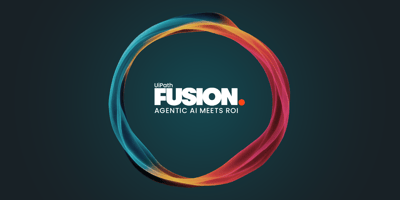10 UiPath innovations furthering agentic automation
Share at:

We’re not just witnessing the evolution of automation—UiPath and our incredible global developer community are bringing it to life. That was the energy coursing through every keynote, demo, and hallway chat at UiPath DevCon in Bengaru, India, April 30. (If you missed the live event, you can catch up on all sessions May 14 at DevCon Online.)
Across DevCon sessions, we highlighted the 10 most powerful UiPath innovations that enable the UiPath Platform™ to lead the way into the agentic age.
Let’s unpack those innovations, explore how each pushes the boundary of what’s possible, and examine how it all fits into the larger vision of agentic automation.
Welcome to agentic automation era
Robots gave us technology to emulate how people do repetitive work. With agentic automation, this is the first time in history we have access to technology that starts to truly emulate the human mind. The agentic automation platform we built unifies AI, RPA, and human decision making so companies can deliver smarter, more resilient workflows without added complexity. As models and chips commoditize, the value of AI moves up the stack to orchestration and intelligence. That’s where UiPath leads.
Daniel Dines, Founder and CEO, UiPath
Traditional robotic process automation (RPA) gave enterprises a great head start, but real-world business processes have become more complex and multi-system, needing greater contextual understanding and adaptive decision making to run smoothly. That’s why UiPath has added AI agents to the mix.
AI agents work alongside robots and people. They reason, learn, and act on their own—but should always remain within clear guardrails.
Agentic automation has arrived. And like RPA before it, what once seemed impossible is now ready for deployment. Not in some distant future, but here and now.
Let’s look at the powerful UiPath innovations making agentic automation possible today.
10 UiPath innovations defining the agentic future
1. UiPath Maestro™
Enterprises can unlock enormous value by simplifying and streamlining their processes with agentic automation. However, they need a careful, orchestrated approach that mitigates the risks and ensures AI agents are introduced to critical processes in a secure and scalable way—all while driving real business outcomes.
Agentic automation needs an orchestration layer to enhance visibility, reduce complexity, and responsibly manage agentic processes. We call this agentic orchestration.
The linchpin of agentic orchestration, UiPath Maestro enables seamless end-to-end processes involving agents, robots, and people. It's the first orchestration layer built from the ground up for agentic processes, with native support for multi-agent environments (spanning UiPath, LangChain, CrewAI, and Salesforce).
Irrespective of which platform the agents or automations were built on, or which AI models they are using, with Maestro, every business can now model, operate, and optimize its processes like a well-tuned symphony involving multiple agents and robots. And people are always in the loop as leaders, coordinators, and ultimate decision makers.
2. UiPath Agent Builder and coded agents
UiPath Agent Builder is a new low-code experience within Studio Web for creating, testing, and deploying AI agents within the UiPath ecosystem. It enables the creation of agents that leverage business data through context grounding, powerful tools (including existing automations, agents, activities, and API workflows), and even natural language-based agent building with UiPath Autopilot™. Agent Builder empowers developers to create specialized AI agents that seamlessly integrate into orchestrated workflows across various systems. These agents utilize features such as tool guardrails, escalation paths, and agent scoring to ensure reliability and auditability.
Coded agents—or agents written in Python with some of our great partners like LangGraph—can now be packaged, published, and run from UiPath Orchestrator. UiPath supports an open ecosystem of UiPath agents, coded agents, people, and robots all working together to help our customers achieve their agentic orchestration goals.
3. UI automation for macOS
To achieve transformational value with agentic automation, access to all enterprise data is a must-have. Every user, regardless of the platform they are using, also needs democratized access to automations that can transform their workflows.
Our industry-leading UI automation is now available for macOS. Users can build, test, and debug enterprise-grade automations with Studio Web—natively on Mac. They can also automate native macOS apps (e.g., Numbers, Pages, Mail), Microsoft Office applications (e.g., Excel), and any Java applications (e.g., SAP GUI). This enables organizations to efficiently scale their automation programs and bring automation to every Mac user.
4. Data Fabric
Imagine having instant access to all your enterprise data—no matter where it's stored—without having to copy, move, or manually stitch it together. That’s the promise of UiPath Data Fabric. It creates a virtualized data layer across your fragmented systems, enabling seamless and consistent access to data across applications and environments.
Data Fabric delivers real-time integration, making data instantly available where it’s needed—without duplication. This “zero-copy” architecture not only reduces storage costs but also breaks down data silos that slow innovation. With built-in governance, access control, and auditability, Data Fabric ensures your data remains secure, compliant, and trusted—making it a game-changer for modern enterprises aiming to be agentic and data-driven.
5. API workflows
This purpose-built API-first canvas enables developers to build fast, scalable, multi-step workflows using APIs. These workflows abstract complex logic and enable agents to work seamlessly across systems via composite services.
Workflows adjust based on real-time data and contextual understanding, driven by agentic decision making. They also facilitate human-in-the-loop exception management and agent testing for enhanced validation of autonomous automations.
6. UiPath Autopilot™ for Developers
Autopilot for Developers is a built-in conversational AI agent that lets developers turn their thoughts into an automation. Thanks to our latest enhancements, now available in public preview, developers can use natural language to create and edit workflows, business processes, and agents—transforming high-level descriptions into detailed automation steps. They can also benefit from contextual AI-driven suggestions to fix errors in real time, use documentation and web search to get guidance and resources tailored to their workflow's context, and quickly troubleshoot issues using the built-in UiPath knowledge base.
With the new Autopilot, developers can build automation solutions faster and more efficiently, all within our unified developer experience.
7. Agentic testing
Agentic testing is a revolutionary approach to software testing where AI agents—including UiPath Autopilot for Testers as well as custom-built agents—augment testers’ expertise to supercharge testing. This new methodology enhances the testing process by incorporating AI-powered capabilities such as automated test case generation, test result analysis, and natural language search for complex queries.
With its ability to streamline and accelerate the entire testing lifecycle, agentic testing is poised to transform the way organizations approach software quality assurance, making testing more efficient, effective, and enjoyable.
8. Healing Agent
We're excited to share that Healing Agent is now generally available. It offers intelligent self-healing to ensure UI automations continue running uninterrupted, even when unexpected application changes occur. It also provides actionable recommendations for fixing automation issues—without the need for further troubleshooting or debugging. Healing Agent enables organizations to enhance their automation efficiency, while reducing their maintenance efforts and downtime cases.
9. UI Agent
UI Agent is a natural language-driven agent that understands user intent, plans multi-step tasks, and autonomously executes actions across interfaces. Think of it as the full self-driving engine for UI automation. It complements traditional RPA by blending structured logic with intuitive, semantic capabilities. RPA is the logical "left brain," ideal for predictable tasks, while UI Agent acts as the intuitive "right brain," adept at handling dynamic and unpredictable environments.
This combination can significantly lower total cost of ownership (TCO) by enhancing resilience and reducing development complexity. Automations that previously required intricate logic can now easily interact with dynamic data and complex UI elements through natural language. Additionally, UI Agent unlocks entirely new automation scenarios, powered by the semantic cognitive engines behind large action models (LAMs).
Our ‘best of both worlds’ approach ensures you benefit from both the predictability of structured robotic automation and the flexible, semantic intelligence associated with AI agents.
10. UiPath IXP
The vast majority of business context is trapped within complex and unstructured data types. AI agents will need a consistent, reliable means to access all enterprise data at speed and scale.
UiPath IXP (Intelligent Xtraction and Processing) is a multimodal data classification and extraction experience that unlocks enterprise data. It brings together our existing, and category-leading IDP capabilities—document understanding and communications mining—with a new prompt-driven capability for unstructured and high-complexity documents called generative extraction. UiPath IXP is built for fast time to value and a seamless user experience, turning all document and communications data into insight and action at speed and scale.
More than new innovations, agentic is a new way of thinking about automation
At DevCon it was clear: this isn’t just a new chapter for automation—it’s a new mindset.
Two key ideas stood out:
Workflows are now living systems
With the introduction of UiPath Maestro and the redesigned workflow engine, UiPath is rethinking how automation is built and run. Agentic orchestration truly brings the best of the UiPath Platform™ together; it’s a single canvas, a single artifact, for you to define and design your business process.
That single canvas includes AI agents, robots, people, and APIs—all operating in sync, all fully observable. You can now design and manage processes that adapt in real time, with every decision, action, and outcome traceable and easy to refine.
Open ecosystems, grounded in trust, are key
Agentic automation isn’t about locking you into any particular tools or platforms. It’s about giving you flexibility with control. UiPath Maestro can orchestrate agents from UiPath, LangChain, CrewAI, Salesforce, and others, all in the same flow.
As I explained at DevCon, the cool thing about agents is it’s easy to build demos. The hard and tricky thing is to convert them into things that actually work in production.
That’s where the UiPath AI Trust Layer, agent scoring, built-in governance, and security controls come in. You can scale agents confidently—because every one of them is monitored, evaluated, and accountable.
Where we go from here
The agentic future is no longer a concept. It’s here, and it’s running in production.
On May 14, join us for DevCon Online—we’ll be bringing you all the sessions from our in-person event in Bengaluru, India, plus some exclusive online-only sessions. You’ll get to see these powerful UiPath innovations in action throughout the half-day virtual event.
Get articles from automation experts in your inbox
SubscribeGet articles from automation experts in your inbox
Sign up today and we'll email you the newest articles every week.
Thank you for subscribing!
Thank you for subscribing! Each week, we'll send the best automation blog posts straight to your inbox.




